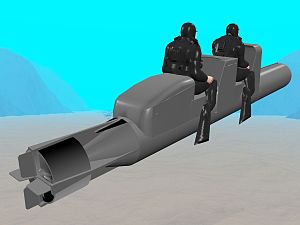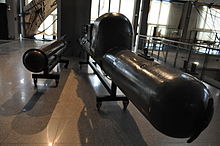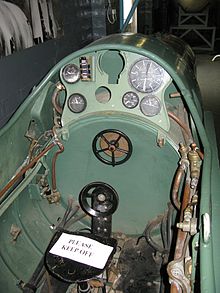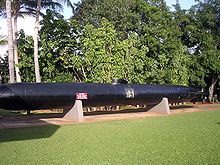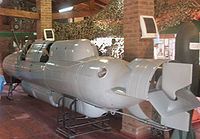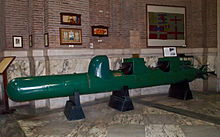- Human torpedo
-
Human torpedoes or manned torpedoes are a type of rideable submarine used as secret naval weapons in World War II. The basic design is still in use today; they are a type of diver propulsion vehicle.
The name was commonly used to refer to the weapons that Italy, and later Britain, deployed in the Mediterranean and used to attack ships in enemy harbours. A group of a dozen countries used the human torpedo, from Italy and Great Britain to Argentina and Egypt, and there are some museums and movies dedicated to this naval weapon. The human torpedo concept is used recreationally for sport diving.
Contents
Characteristics
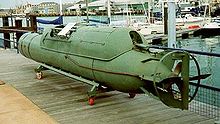 Italian manned torpedo, a maiale, at the Royal Navy Submarine Museum.
Italian manned torpedo, a maiale, at the Royal Navy Submarine Museum.
The first human torpedo (the Italian Maiale) was electrically propelled, with two crewmen in diving suits riding astride. They steered the torpedo at slow speed to the enemy ship. The detachable warhead was then used as a limpet mine. They then rode the torpedo away.
In operation, the Maiale torpedo was carried by another vessel (usually a normal submarine), and launched near the target. Most manned torpedo operations were at night and during the new moon to cut down the risk of being seen.
The idea was successfully applied by the Italian navy (Regia Marina) early in World War II and then copied by the British when they discovered the Italian operations. The official Italian name for their craft was Siluro a Lenta Corsa (SLC or "Slow-running torpedo"), but the Italian operators nicknamed it maiale (Italian for "pig"; plural maiali) because it was difficult to steer. The British copies were named "chariots".
Construction
A typical manned torpedo has a propeller and hydroplanes at the rear, side hydroplanes in front, and a control panel and controls for its front rider. It usually has two riders who sit facing forwards. It has navigation aids such as a compass, and nowadays modern aids such as sonar and GPS positioning and modulated ultrasound communications gear. It may have an air (or other breathing gas) supply so its riders do not have to drain their own apparatus while they are riding it. In some the riders' seats are enclosed; in others the seats are open at the sides as in sitting astride a horse. The seat design includes room for the riders' swimfins (if used). There are flotation tanks (typically four: left fore, right fore, left aft, right aft), which can be flooded or blown empty to adjust buoyancy and attitude.
Timeline
- 1 November 1918: Two men of the Regia Marina, Raffaele Paolucci and Raffaele Rossetti, in diving suits, rode a primitive manned torpedo (nicknamed Mignatta or "leech") into the Austro-Hungarian Navy base at Pola (Istria), where they sank the Austrian battleship Viribus Unitis and the freighter Wien using limpet mines. They had no breathing sets and they had to keep their heads above water, and thus they were discovered and taken prisoner.[1]
- 1938: In Italy the "1a Flottiglia Mezzi d'Assalto" (First Fleet Assault Vehicles) was formed as a result of the research and development efforts of two men - Major Teseo Tesei and Major Elios Toschi of the Italian Royal Navy. The pair resurrected the idea of Paolucci and Rossetti.
- 1940: Commander Moccagatta of the Italian Royal Navy reorganised the 1st Fleet Assault Vehicles into the Decima Flottiglia MAS (Tenth Light Flotilla of assault vehicles) or "X-MAS", under the command of Ernesto Forza. It secretly manufactured manned torpedoes and trained war frogmen, called nuotatori (Italian: "swimmers").
- 26 July 1941: An attack on Valletta Harbour ended in disaster for the X MAS and Major Teseo Tesei lost his life.
- 19 December 1941: The Decima Flottiglia MAS attacked the port of Alexandria with three maiali. The battleships HMS Valiant and Queen Elizabeth (and an 8,000-ton tanker) were sunk in shallow water putting them out of action for many months. Luigi Durand de la Penne and five other swimmers were taken prisoner. De la Penne was awarded the Medaglia d'oro al Valor Militare after the war.
- October 1942: Two British chariots were carried aboard the Shetland Bus fishing-boat Arthur to attack the Tirpitz on Operation Title. They were swung overboard once in Norwegian waters but both became detached from their tow-hooks in a gale and the operation was a total failure.[2]
- 8 December 1942. An attack by three manned torpedoes from the auxiliary ship Olterra against British naval targets is thwarted in Gibraltar. Three divers were killed by depth charges when the British harbour defence "reacted furiously" to the attack. Among the dead were Lt Licio Visintini, commander of the divers unit on board the Olterra, Petty Officer Giovanni Magro and Sergeant Salvatore Leone, from Taormina, Sicily. Leone's body was never found. Sgt Leone was awarded the Medaglia d'oro al Valor Militare and a memorial was erected in the Community Gardens in Taormina on the 50th anniversary of the attack. The memorial includes a rebuilt maiale and a description of the events, in three languages.
- 1–2 January 1943: British submarines Thunderbolt, Trooper and P311 took part in Operation Principal. P311 was lost en route to La Maddelena but the other two boats had some success at Palermo, launching two and three Chariots respectively. The Ulpio Traiano was sunk and the stern torn off Viminale. However the cost was high with one submarine and one chariot lost and all but two charioteers captured.
- 18 January 1943: Thunderbolt took two chariots to Tripoli for Operation Welcome. This was to prevent blockships being sunk at the harbour mouth, so denying access to the Allies. Again, partial success was achieved. This was the last operation in which chariots were carried in containers on British submarines, although some others followed with the chariots on deck without containers.
- 6 May & 10 June 1943: Italian maiali from the Olterra, now under the command of Lt Ernesto Notari, sunk six Allied merchant ships in Gibraltar, for a total of 42,000 tn.
- 2 October 1943: A bigger Italian frogman-carrier, 10 metres (33 ft) long and carrying four frogmen, called Siluro San Bartolomeo, or SSB, was going to attack Gibraltar, but Italy surrendered and the attack was called off.
- 21 June 1944: A British-Italian joint operation was mounted against shipping in La Spezia harbour. The chariots were carried on board an MTB and the cruiser Bolzano was sunk.
- 6 July 1944: A German Neger type vessel torpedoed the Royal Navy Minesweepers HMS Magic and Cato.[3]
- 8 July 1944: A German Neger-type torpedo manned by Lt. Potthast heavily damaged the Polish light cruiser ORP Dragon off the Normandy beaches.
- 20 July 1944: Royal Navy destroyer HMS Isis was mined at anchor in Seine Bay. A German Human Torpedo was believed responsible.[3]
- 27–28 October 1944: The British submarine Trenchant carried two Mk 2 Chariots (nicknamed Tiny and Slasher) to an attack on Phuket harbor in Thailand. See British commando frogmen for more information about this attack. No manned torpedo operations in combat in any war are known with certainty of after this date.
- Immediate post-war period: The British Chariots were used to clear mines and wrecks in harbours.
For other events, see Operations of X Flottiglia MAS and British commando frogmen.
Some nations including Italy have continued to build and deploy manned torpedoes since 1945.
Italy
Raffaele Rossetti in 1918 created a new weapon, based on his bright idea of a torpedo manned by a person, to be linked to enemy vessels underwater and explode under the ship hull. This weapon was called "mignatta" (leech) and was the precursor of the maiale of World War II and the actual human torpedo.
World War II
 A maiale in Taormina, Sicily
A maiale in Taormina, Sicily
- Siluro a Lenta Corsa (Italian, Low Speed Torpedo – SLC), also known as maiale (Italian for "pig", plural maiali).[4]
- Siluro San Bartolomeo (Italian, St. Bartholomew Torpedo, also called SSB). It was never used in action. Image at this link.
For information on Italian manned torpedo operations, see Decima Flottiglia MAS.
 Media related to Maiale manned torpedo at Wikimedia Commons
Media related to Maiale manned torpedo at Wikimedia CommonsAfter 1945
- CE2F/X100 is a make of chariot made after 1945. There is an image of it on this link. They are made in Italy. Range 50 miles (80 km). 2 riders. The Pakistan Navy has several of them. India and Argentina also have some.[5] Recent upgrades include:
United Kingdom
- World War II
- Chariot Mark 1, 6.8 m (22 feet 4 inches) long, 0.9 m (2 feet 11 inches) wide, 1.2 m (3 feet 11 inches) high, speed 2.5 knots (4.6 km/h), weight: 1.6 tonnes, maximum diving depth: 27 m. Endurance 5 hours (distance depended on water current). Its control handle was
 -shaped. 34 were made.
-shaped. 34 were made. - Chariot Mark II, 30 ft 6 in (9.3 m) long, 2 ft 6 in (0.8 m) diameter, 3 ft 3 in (1 m) maximum heighr, weight 5200 pounds (2359 kg), max speed 4.5 knots, range 5-6 hours at full speed, had two riders, who sat back to back. 30 were made.[6]
-
- Both types were made by Stothert and Pitt (crane makers) at Bath, Somerset.
For information on British manned torpedo operations, see British commando frogmen.
Germany
- World War II
- Neger
- This extreme form of a genuine human torpedo[3] carried a second torpedo underneath, which was launched at the target. Speed: 4 knots (7.4 km/h), and about 10 hours at 3 knots. One seat. This manned torpedo was named after its inventor Richard Mohr.
- Marder and Biber
- These very small submarines carried two torpedoes and one or two men. There were other types that never ran into production.
In July 1944 the German Navy introduced their human torpedoes to harass allied positions at Normandy anchorages. Although they could not submerge, they were difficult to observe at night and inflicted several losses on allied vessels.[3]
See also: German commando frogmenJapan
- World War II
- Kaiten. The Kaiten was a manned fast torpedo, which was piloted straight into its target, which in practice was a suicide weapon. As such their operations differed substantially from those of the Italian, British and German.
Russia/USSR
- After 1945
- Siren. It is or was made after 1945. It is longer than a British or Italian Chariot because it has 2 warheads. It has 2 riders. It was designed to exit through a submarine's torpedo tube. See Russian commando frogmen.
United States
- After 1945
There are pictures and descriptions of modern US Chariot-like underwater frogman-carriers used by SEALs and a fast surface boat that can submerge, here:
Other countries
Argentina
In Argentina were developed manned torpedoes and special minisubmarines in the 1950s, the latter with a torpedo attached under the two-men crew. Their crews were trained by Eugenio Wolk, a former member of the Italian Decima MAS.
Egypt
This photograph was taken at a military parade in Cairo in 1963. It shows two chariots, each two-seat, and their riders' legs are enclosed.
Poland
Yugoslavia
The Yugoslav Navy did not have manned torpedoes, but frogmen used the underwater device called R-1 Diver for a variety of missions, including: mine clearance, infiltration, clandestine surveillance and security, and assault missions on enemy shipping and naval objects. These small apparatuses were relegated to the navies of Croatia (HRM) (1991) and Montenegro (2007).
Museums
- Original SLC's (Siluri Lenta Corsa or "Maiale") are displayed at the Venice Naval History Museum.
- There are three chariots on public view in Eden Camp Museum near Malton, North Yorkshire in England:
- A restored original British Mark II, which was found derelict in a scrapyard in Portsmouth. In this design, the two riders sat back to back.
- A working chariot that was made in 1992 in Milton Keynes with approximately the outside appearance of a British wartime Mark I, but with differing internal working parts. It has been filmed in action for the television. It has a dummy warhead. Image at this link. It was last used in 2006.
- A replica Italian maiale made soon after 1945 by the same Italian firm (Caproni) who made the wartime maiali. As at July 2008 this was on loan to the National Maritime Museum Cornwall in Falmouth, Cornwall until the end of 2008, but as at 16 March 2009 it was back in Eden Camp.
- There is an Italian SSB maiale in the Naval Museum at Groton, Connecticut in the USA.
Movies and fiction
- The movie The Valiant, made in 1962, is about the sinking of the HMS Valiant in Alexandria harbour. There it is even a 1953 Italian movie (I sette dell'Orsa Maggiore) about the attack, done with some real members of Decima Flottiglia MAS as support actors in the cast.
- The film Above Us the Waves (released in 1955) concentrates on the midget submarine attack on Tirpitz battleship. The film has a scene of a fight between British and German frogmen at an anti-submarine net; this never happened in the real attack on the Tirpitz.
- The film The Silent Enemy (released in 1958) does not represent real events accurately. In particular, in the real world there was no attack on the Olterra, and no underwater hand-to-hand battle between Italian and British frogmen. The breathing sets used by the film actors representing the Italian frogmen seem to be British naval type rebreathers and not authentic Italian rebreathers. The three chariots seen in the movie, representing Italian maiali, were crudely-made film props.
- A film The Eagle Has Landed briefly features a German paratroop Officer, a Colonel played by Michael Caine and his men who have been sent to man chariots on the Channel Islands.
- Ian Fleming who wrote the James Bond stories was in Naval Intelligence stationed at Gibraltar in the war, and was likely aware of the Italian operations. The chariot seen in the James Bond film On Her Majesty's Secret Service is a realistic-looking but non-functioning film prop. When seen it is in a kit store. It does not take part in any action; the action happens up a mountain in the Swiss Alps. Underwater vehicles (not chariot-shaped) featured in the James Bond film Thunderball.
- In Metal Gear Solid, Solid Snake uses one to approach Shadow Moses island.
- In Infinity Ward's Call of Duty: Modern Warfare 2, Operators from "Task Force 141" uses two of these to approach one of the four oil rigs. This takes place in the mission: The only easy day, was yesterday.
- In the game Battlestations: Pacific, Kaitens and Kaiten-carrying submarines are player-controllable units.
Chariots for sport diving
At least two makes of chariot-like diver-riders for sport divers were on sale in the diving gear trade for a while after 1960.
One of those makes was tradenamed "Dolphin" and was made on the Isle of Wight. In the 1960s or 1970s, both ends were tapered to a point.
Another type was USA-made and looked like a wartime chariot but its hull was thinner.
Media
-
Human torpedo pioneer Teseo Tesei, of the Regia Marina, was killed during an operation in 1941
See also
Notes
- ^ Photographies of the "mignatta", the first human torpedo invented by Raffaele Rossetti, and the "Viribus Unitis" sinking
- ^ Quick, D. (1970). "A History Of Closed Circuit Oxygen Underwater Breathing Apparatus". Royal Australian Navy, School of Underwater Medicine. RANSUM-1-70. http://archive.rubicon-foundation.org/4960. Retrieved 2009-03-20.
- ^ a b c d Brown p. 115
- ^ Image at this link. Pages 6–11, issue 39, Historical Diving Times has several large photographs of one recovered after an attack on Malta on 26 July 1941
- ^ "Stealing the Sword: Limiting Terrorist Use of Advanced Conventional Weapons", p. 60
- ^ pp 61 & 62, Chariots of War, by Robert W. Hobson, publ. Ulric Publishing, Church Stretton, Shropshire, England, 2004, ISBN 0 954 1997 1 5
References
- Brown, David. Warship Losses of World War Two. Arms and Armour, London, Great Britain, 1990. ISBN 0-85368-802-8.
- C. Warren and J. Benson - Above Us The Waves (Harrap 1953)
- Junio Valerio Borghese - Sea Devils (1954)
- Robert W. Hobson - "Chariots of War" (Ulric Publishing 2004) ISBN 0-9541997-1-5
- Jack Greene and Alessandro Massignani - The Black Prince and the Sea Devils: The Story of Prince Valerio Borghese and the Elite Units of the Decima Mas (2004) ISBN 0-306-81311-4
- Mitchell, Pamela - Chariots of the Sea Richard Netherwood (1998) ISBN1-872955-16-9
External links
- The British Chariots, diving gear and personal experiences
- Chariots in armed forces service after 1945
- Vostok: a French 2-man diver-rider that may be a chariot (article in French)
- Underwater Heritage Trust
- Eden Camp Museum
- More images of the restored British Mark II chariot
- Comando Supremo: Italy at War
- British submarines of World War 2
- Chariots, accounts of operations, pictures
- Roll of honour, awards and images for chariots and midget submarines.
- Underwater Warriors
- Japanese suicide weapon:Human torpedo Kaiten(Japanese)
- HNSA Ship Page: Italian Siluro San Bartolomeo
Categories:- Diving equipment
- Submarines
- Torpedoes
- World War II weapons of Italy
- Submarine classes
- World War II submarines of the United Kingdom
- Frogman operations
- Italian inventions
- Naval weapons of Italy
- Midget submarines
- Wet submarines
Wikimedia Foundation. 2010.

